|
Based on: Desert Hermits, Byzant. MS. illum., ca, 1081 Princeton Univ. Library. imge modif . |
|
|
Based on: Desert Hermits, Byzant. MS. illum., ca, 1081 Princeton Univ. Library. imge modif . |
|
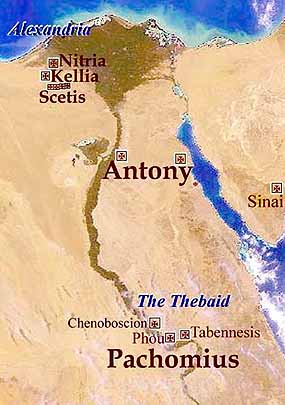 |
The communities of NITRIA (ca. 330), KELLIA (ca. 338), and SCETIS (ca 330), south of Alexandria.
The site of Antony’s fort on the Nile and his hermitage on the Red Sea (ca. 313)
Pachomius’ Nile-side foundations in the Thebaid (ca. 320): completely cenobitic, modelled on the Imperial army |
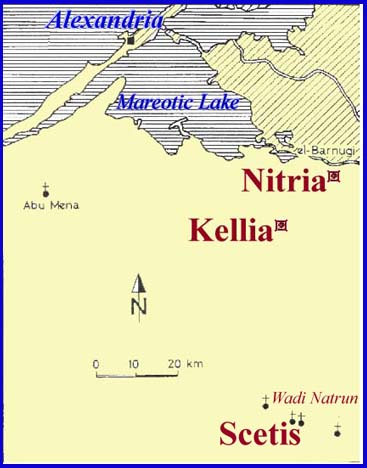 |
The ancient monastic site of NITRIA was founded by Amoun in 330. Sadly, no archeological remnants of Nitria exist. All evidence of the original monastic buildings has been eradicated by modern agriculture: water rapidly destroys ancient ruins made of baked mud. |
|
|
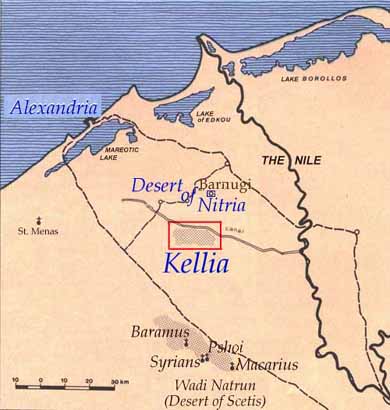 |
|
|
Kellia, also called The Cells, was founded by Amoun in 338, about six miles south of Nitria. According to legend, Amoun founded this hermit colony on the advice and with with the assistance of Antony. The purpose of Kellia was to provide a site near Nitria for monks who desired greater solitude |
The Legend of the Founding of Kellia
from Benedicta Ward’s The Sayings of the Desert Fathers.
The Greek Alphabetical Collection of the Apophthegmata, Migne, PG 65.72-440,
| 34. ABBA ANTONY once went to visit Abba Amoun in Mount Nitria and when they met, Abba Amoun said, ‘By your prayers, the number of the brethren increases, and some of them want to build more cells where they may live in peace [hesuchia]. How far away from here do you think we should build the cells?’ Abba Anthony said, ‘Let us eat at the ninth hour and then let us go out for a walk in the desert and explore the country.’ |
λδ. Παρέβαλέ ποτε ὁ ἀββᾶς Ἀντώνιος τῷ ἀββᾷ Ἀμοῦν εἰς τὸ ὄρος τῆς Νιτρίας͵ καὶ μετὰ τὸ συντυ χεῖν ἀλλήλοις͵ λέγει αὐτῷ ὁ ἀββᾶς Ἀμοῦν· Ἐπειδὴ διὰ τῶν εὐχῶν σου ἐπληνθύθησαν οἱ ἀδελφοὶ͵ καὶ θέλουσί τινες αὐτῶν οἰκοδομῆσαι κελλία μακρὰν ἵνα ἡσυχάσωσι͵ πόσον κελεύεις ἵνα ἀπέχῃ διάστημα τὰ κτιζόμενα κελλία τῶν ἐνταῦθα; Ὁ δὲ εἶπε· Γευσώ μεθα ὥραν ἐνάτην͵ καὶ ἐξέλθωμεν͵ καὶ διακινήσωμεν τὴν ἔρημον͵ καὶ σκοποῦμεν τὸν τόπον. |
| So they went out into the desert and they walked until sunset and then Abba Anthony said, ‘Let us pray and plant the cross here, so that those who wish to do so may build here. Then when those who remain there want to visit those who have come here, they can take a little food at the ninth hour and then come. If they do this, they will be able to keep in touch with each other without distraction of mind.’ The distance is twelve miles. | Ὡς δὲ ὥδευσαν [65.88] τὴν ἔρημον ἕως οὗ ἐλθεῖν δῦναι τὸν ἤλιον͵ λέγει αὐτῷ ὁ ἀββᾶς Ἀντώνιος· Ποιήσωμεν εὐχὴν καὶ στή σωμεν ὧδε σταυρὸν͵ ἵνα ὧδε κτίσωσιν οἱ θέλον τες κτίσαι͵ ἵνα καὶ οἱ ἐκεῖθεν͵ ὅταν παραβάλωσι τού τοις͵ γευσάμενοι τὸ μικρὸν βουκὶν αὐτῶν ὥραν ἐνάτην͵ οὕτως παραβάλωσι͵ καὶ οἱ ἔνθεν ἀπερχόμενοι͵ τὸ αὐτὸ ποιοῦντες͵ ἀπερίσπαστοι μένωσιν ἐν τῷ παραβάλλειν ἀλλήλοις. ῎εστι δὲ τὸ διάστημα σημεῖα δεκαδύο. |
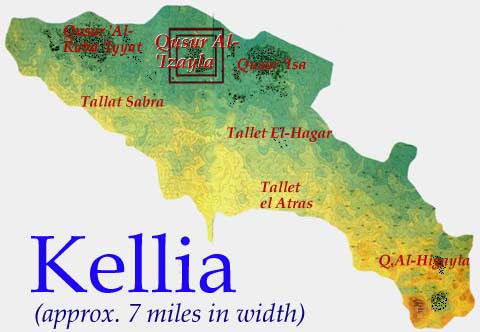 |
|
An archeological plan of Kellia, showing excavated sites and (in green) the hydrological danger from agriculture (90% of the site has been destroyed). The tiny black dots are individual hermitages, of which there were more than 1500 by the seventh century. The area marked with a red square (Qusur Al ’Izayla) is enlarged below to show the individual hermitages and churches of the area. |
|
|
The 130 cells |
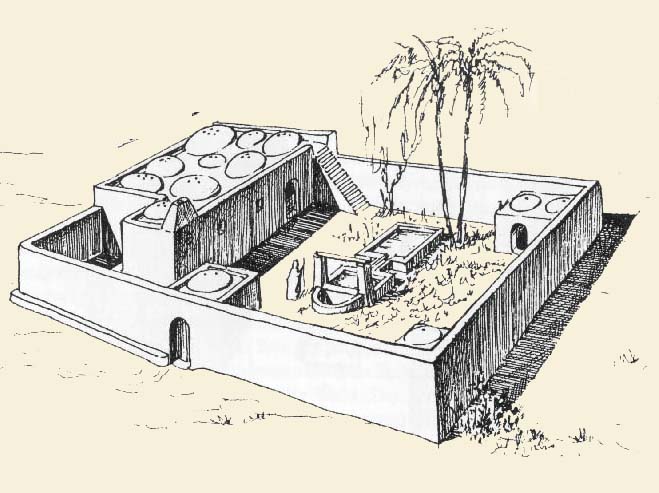 |
|
| Typical 6th c. mud- brick Hermitage at Kellia, (accom.1-3 monks) | Looking North from Scetis |
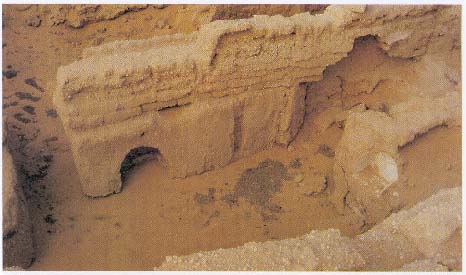 |
Much more primitive fourth-century hermit’s cell in Kellia: effectively a trench in the ground with mud-brick walls and a mud-brick roof. |
|
Diagram
of an excavated fourth-century cell. Note the niche in the
wall with an ornamental cross. |
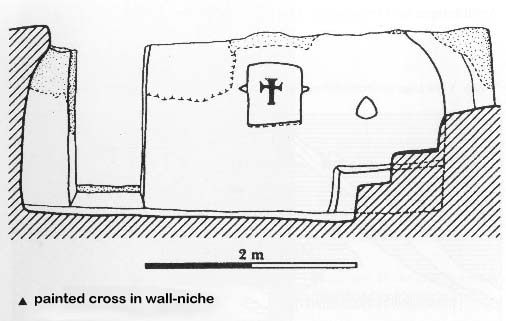 |
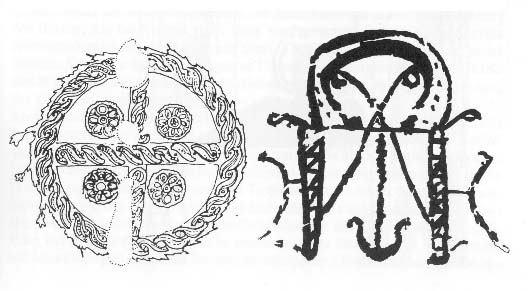 |
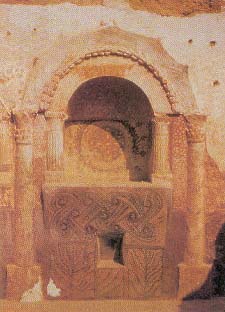 |
In the later tradition stylized crosses were the only ornamentation.
|
|
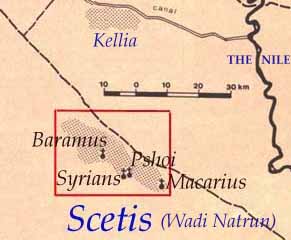 |
Scetis, in the |
The four monasteries of the Wadi Natrun, shown here, have recently become impotant centers in the revitalization of Coptic church life
|
Monastic life still flourishes in the communities of:
(1)
Baramus (the
Romans); St. Bishoi Monastery, Wadi-Natrun |
|
|
|
|
|
This Webpage was created for a workshop held at Saint Andrew's Abbey, Valyermo, California in 1990